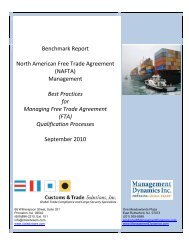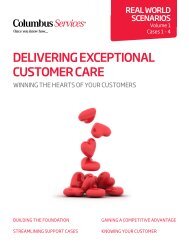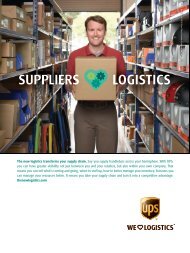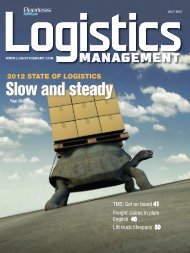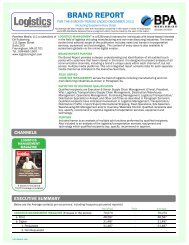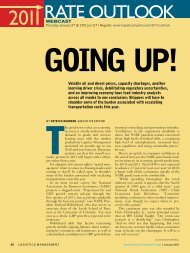to download PDF article - Logistics Management
to download PDF article - Logistics Management
to download PDF article - Logistics Management
Create successful ePaper yourself
Turn your PDF publications into a flip-book with our unique Google optimized e-Paper software.
5supply chain & logistics technology<br />
trends driving tMs<br />
groWth<br />
<strong>to</strong>p supply chain software analysts break down the drivers that<br />
will keep the transportation management systems market on a<br />
steady upswing for years <strong>to</strong> come.<br />
BY bridget Mccrea, contriButing edi<strong>to</strong>r<br />
Relied on for their innate ability <strong>to</strong> handle transportation<br />
planning, decision making, follow up, and<br />
measurement for companies of all sizes and across<br />
all industries, transportation management systems<br />
(TMS) held their own by posting positive sales<br />
growth through the recession and are poised for growth in 2012.<br />
Credit the fact that these systems can shave percentage<br />
points off of transportation spending, create efficiencies that<br />
were previously out of reach, and come in the attractive SaaS<br />
(software as a service) format with helping <strong>to</strong> keep many TMS<br />
vendors in the black during the last three tumultuous years.<br />
“In 2010, the TMS market grew significantly faster than<br />
the rate of inflation, or roughly 6.1 percent, and we’re forecasting<br />
an additional 6.8 percent compound annual growth<br />
through 2015 for the market,” says Steve Banker, service<br />
direc<strong>to</strong>r for supply chain management at the ARC Advisory<br />
Group. “It looks like the market is holding up pretty well.”<br />
Banker singles out planning and execution systems—the end<strong>to</strong>-end<br />
solutions used by shippers who utilize carriers <strong>to</strong> move<br />
their freight—as the largest and fastest growing segment of the<br />
TMS market. In highest demand right now, says Banker, are the<br />
networked SaaS solutions that facilitate high quality electronic<br />
communication with partners, enable fast on-boarding of new<br />
partners, enhance transportation procurement efficiencies, and<br />
allow for freight audit and pay improvements.<br />
In this <strong>article</strong> we’ll look at five key trends that will help<br />
cement TMS’ status as a growing supply chain software<br />
segment in 2012. According <strong>to</strong> our analysts, the demand for<br />
system upgrades, the growth in intermodal transportation,<br />
and a new focus on “big data” requirements are helping <strong>to</strong><br />
sustain a healthy TMS market.<br />
1<br />
older systeMs need facelifts<br />
If there is a single, primary driver for the TMS market<br />
right now it’s the fact that many systems are outdated.<br />
Many of the solutions in operation <strong>to</strong>day were<br />
installed five <strong>to</strong> 10 years ago—before tablet computers and<br />
mobile technologies had come <strong>to</strong> the forefront of the business<br />
world.<br />
That will pave the way for more TMS upgrades in 2012,<br />
says Banker. “The business case for supply chain application<br />
upgrades are often difficult <strong>to</strong> make,” he says, “but with TMS<br />
there are so many different ways <strong>to</strong> save money.” For example,<br />
Banker says solid arguments in favor of a TMS upgrade<br />
include the money saved when preferred carriers are used on<br />
a regular basis or when preferred procurement positions are<br />
successfully negotiated and orchestrated.<br />
Other areas where TMS can assist include use of fully loaded<br />
vehicles and improved routing and scheduling tactics. To companies<br />
that will be upgrading this year Banker says <strong>to</strong> focus first<br />
on outbound transportation (load consolidation, better routing,<br />
and so forth) when making the case, “and then move in<strong>to</strong> procurement<br />
negotiations and other advanced features that you<br />
can’t get from any other [supply chain] application.”<br />
42 <strong>Logistics</strong> ManageMent WWW.LOGISTICSMGMT.COM | January 2012
the 28 vendors that participated in the 2011 profile of the<br />
transportation <strong>Management</strong> systems Market survey<br />
Vendor product home market<br />
transportation <strong>Management</strong> systems<br />
centric Logistic solutions Plan&go! the netherlands, europe<br />
esPritec s.r.L. gesPe tMs italy<br />
Four soft Limited 4s etrans / 4s etrans sMe / 4s infotips / 4s VisiLog asia Pacific<br />
greencat cat4roadHaulier / roadrunner+ Benelux<br />
i2 technologies i2 transportation Bid collaboration / i2 transportation Managment<br />
solution / i2 supply chain Visibility<br />
January 2012 | WWW.LOGISTICSMGMT.COM <strong>Logistics</strong> ManageMent 43<br />
global<br />
iBM sterling commerce iBM sterling transportation <strong>Management</strong> system north america<br />
imtech ict austria gmbH cargonet, LBase tMs austria, France, germany, switzerland, uK<br />
informore Logic<strong>Logistics</strong> L2 for shippers europe<br />
intris group tris <strong>Logistics</strong> application suite / tris tMs Belgium, the netherlands<br />
Jda software group Jda Fleet <strong>Management</strong> / Jda transportation Planning / Jda shipment<br />
execution<br />
Kewill Kewill Forwarding / Kewill <strong>Logistics</strong> / Kewill service <strong>Logistics</strong> europe<br />
north america<br />
MP objects MPo supply chain suite Benelux<br />
oracle nederland oracle transportation <strong>Management</strong> (otM) global<br />
Precision software—a division<br />
of Qad inc.<br />
Precision global trade <strong>Management</strong> / Precision trade compliance<br />
/ Precision transportation <strong>Management</strong> / Qad supply chain Portal<br />
north america<br />
Qurius Q-tMs the netherlands<br />
redPrairie collaboration Portal / Fleet / Parcel / transportation Manager global<br />
saP ag saP transportation <strong>Management</strong> global<br />
shipitsmarter.com shipitsmarter.com / trackitsmarter the netherlands, germany<br />
tesi spa net Mover italy<br />
transics tas / tX-connect / tX-sociaL / tX-Visio europe<br />
transplace transplace transportation <strong>Management</strong> system north america<br />
transporeon tisYs germany<br />
Wexlog technologies WexVs for transportation and <strong>Logistics</strong> europe<br />
Young & Partners navitrans Forwarding / navitrans transport<br />
transportation planning systems<br />
Belgium<br />
ortec ortec shortrec / ortec Loaddesigner / ortec transport & distribution<br />
(otd)<br />
europe<br />
PtV nederland BV inter<strong>to</strong>ur Benelux<br />
Quintiq Quintiq europe<br />
roadnet technologies inc. Mobilecast / roadnet / terri<strong>to</strong>ry Planner north america<br />
source: capgemini consulting<br />
2<br />
interModal in groWth Mode<br />
Manual and aging transportation management<br />
systems may cut it when all shippers have <strong>to</strong> choose<br />
between are truckload and less-than-truckload moves.<br />
Throw a few more complications in<strong>to</strong> the ring, however, and<br />
a company’s ability <strong>to</strong> efficiently manage freight movement<br />
up and down the supply chain becomes extremely difficult.<br />
The growth in intermodal, which involves the use of more<br />
than one mode of transport during a specific journey, makes the<br />
situation even more complex. “We’re seeing a lot more companies<br />
shipping via intermodal,” says Dwight Klappich, research vice<br />
president for Gartner, “and many of the systems that those firms<br />
were using in the past don’t fit with intermodal movement.”<br />
The brick-and-mortar manufacturer that begins selling<br />
directly <strong>to</strong> consumers online, for example, will likely find its<br />
existing supply chain solutions <strong>to</strong> be inadequate for handling the<br />
new line of business. “Add small-package shipping <strong>to</strong> the lineup<br />
and their TMS will no longer fit,” says Klappich.<br />
The shipper that expands globally will face similar challenges<br />
when it tries <strong>to</strong> manage multiple rail, truck, and ocean<br />
shipments. “Intermodal can be a complicated process for the<br />
firm that hasn’t dealt with it in the past,” says Klappich, who<br />
expects the intermodal trend <strong>to</strong> continue in<strong>to</strong> 2012. “We’re<br />
definitely seeing more of it, as well as a need for a more robust<br />
TMS <strong>to</strong> handle the multidimensional shipping approach.”<br />
3<br />
tMs Vendors Will go beyond execution<br />
In its 2011 Transportation <strong>Management</strong> Report, research<br />
firm Capgemini Consulting outlined the various components<br />
that make up the execution side—as opposed <strong>to</strong><br />
the planning aspect—of a typical TMS.<br />
Basic execution functions include: order entry and<br />
consolidation (registration, validation and management of<br />
orders); dispatching (confirmation reports for carriers and/or
supply chain & logistics technology<br />
TMS functional reference model and domains<br />
Strategic Transport<br />
Sourcing<br />
Tactical<br />
Operations<br />
Capacity<br />
management<br />
Shipping<br />
consolidation<br />
and load/trip<br />
planning<br />
Load design<br />
Route planning<br />
Fleet & driver<br />
planning<br />
Carrier selection<br />
Performance<br />
management<br />
Asset & fleet<br />
management<br />
Order entry &<br />
consolidation<br />
Dispatching<br />
Yard<br />
management<br />
Execution<br />
moni<strong>to</strong>ring<br />
Order status<br />
information<br />
Parcel<br />
management<br />
drivers); order status information (recording<br />
information related <strong>to</strong> the pickup,<br />
collection and delivery of shipments);<br />
global logistics execution (cus<strong>to</strong>ms and<br />
transport documents); and yard/parcel<br />
management.<br />
As evidenced by Capgemini’s report,<br />
the execution component of a TMS<br />
covers a lot of valuable ground for<br />
shippers, but that hasn’t s<strong>to</strong>pped vendors<br />
from coming up with new additions<br />
that push their systems beyond<br />
the basics. “One of the biggest trends<br />
we’re seeing right now are TMS that<br />
are trying <strong>to</strong> be more than just execution<br />
systems,” says Chris Caplice,<br />
executive direc<strong>to</strong>r at Massachusetts<br />
Institute of Technology’s Center for<br />
Transportation and <strong>Logistics</strong>.<br />
“Basically, a TMS gathers the information<br />
on a load <strong>to</strong> be tendered and<br />
matches that data <strong>to</strong> a his<strong>to</strong>rical routing<br />
guide. Then it communicates <strong>to</strong> a carrier<br />
and manages the ensuing communication<br />
process,” says Caplice. “The more<br />
advanced TMS is going beyond that and<br />
tapping in<strong>to</strong> other information services<br />
and utilizing that data <strong>to</strong> help the shipper<br />
make the best possible decisions.”<br />
For example, he says that the TMS can<br />
be connected directly in<strong>to</strong> a market data<br />
benchmarking service that funnels data<br />
back <strong>to</strong> the system. “The addition of this<br />
Network design Contract<br />
management<br />
Resource<br />
management<br />
Global logistic<br />
execution<br />
cus<strong>to</strong>ms &<br />
transport<br />
documents<br />
Vehicle<br />
management<br />
Route planning<br />
Communication<br />
Rate & tariff<br />
management<br />
Carrier/<br />
subcontrac<strong>to</strong>r<br />
invoice<br />
settlement<br />
Cus<strong>to</strong>mer billing<br />
Freight bill<br />
auditing<br />
Transport cost<br />
allocation<br />
Time & labor<br />
Planning Execution Vehicle Finance<br />
Source: Capgemini Consulting<br />
au<strong>to</strong>mated, real-time market moni<strong>to</strong>ring<br />
function helps shippers avoid the yearly<br />
or biannual carrier bidding process,” says<br />
Caplice, “positioning the TMS <strong>to</strong> serve as<br />
more than just an execution feed.”<br />
4<br />
systeMs equipped <strong>to</strong><br />
handle big data<br />
Defined as the datasets whose<br />
size is beyond the ability of typical<br />
database software <strong>to</strong>ols <strong>to</strong> capture,<br />
s<strong>to</strong>re, manage, and analyze, “big data”<br />
is big business in <strong>to</strong>day’s corporate environment.<br />
According <strong>to</strong> McKinsey Global<br />
Institute, enterprises globally s<strong>to</strong>red<br />
more than 7 exabytes (one exabyte = one<br />
quintillion bytes) of new data on disk<br />
drives in 2010. That number is expected<br />
<strong>to</strong> grow as companies capture trillions of<br />
bytes of information about their cus<strong>to</strong>mers,<br />
suppliers, and operations.<br />
Managing the data isn’t easy, but<br />
MIT’s Caplice says TMS vendors are<br />
stepping up <strong>to</strong> the plate and developing<br />
systems that make valuable use of the<br />
“big data” that is collected and s<strong>to</strong>red.<br />
“TMS is going beyond just being tendering<br />
systems,” says Caplice, who points<br />
out that transportation as a whole tends<br />
<strong>to</strong> generate rich transactional data. By<br />
drilling down in<strong>to</strong> specific regions or<br />
focusing on particular market trends,<br />
for example, shippers can utilize the<br />
“big data” s<strong>to</strong>red in their TMS <strong>to</strong> make<br />
educated business decisions—the<br />
placement of new DCs, for instance.<br />
“Companies are really only starting <strong>to</strong><br />
tap in<strong>to</strong> this function, but it’s something<br />
that I definitely see continuing <strong>to</strong> gain<br />
momentum in 2012,” says Caplice.<br />
5<br />
More holistic solutions<br />
Intent on becoming one-s<strong>to</strong>pshops<br />
for the shippers that they<br />
serve, <strong>to</strong>day’s third party logistics<br />
providers (3PLs) view TMS as an<br />
important addition <strong>to</strong> their vertically<br />
integrated service offerings.<br />
“We’re seeing a lot more 3PLs trying<br />
<strong>to</strong> come up with TMS systems that<br />
their cus<strong>to</strong>mers can implement,” says<br />
Ellen Chen, MOVE practice leader at<br />
Capgemini. “Those cus<strong>to</strong>mers can then<br />
save money by consolidating and ‘sharing’<br />
those systems with other shippers<br />
or suppliers.” Those shippers that take<br />
the 3PL route also gain the benefit of<br />
a full-blown TMS without the need for<br />
maintenance or management.<br />
Chen says that the trend blends well<br />
with a broader push <strong>to</strong> create holistic<br />
transportation systems that are consolidated<br />
under one roof, rather than being<br />
sold, installed, and managed by multiple<br />
vendors. She’s working with a vendor<br />
right now that’s developing a “cookie<br />
cutter” TMS targeted for the small- <strong>to</strong><br />
medium-sized enterprise that wants<br />
complete functionality without the high<br />
purchase and maintenance costs.<br />
“We’re seeing a lot more RFPs being<br />
issued by shippers seeking holistic transportation<br />
management systems,” says<br />
Chen. “They want deeper, broader solutions<br />
without the extreme costs, and<br />
they see this as a way <strong>to</strong> meet that goal.”<br />
Bullish on TMS vendor’s ability <strong>to</strong><br />
achieve a 6.8 percent growth rate over<br />
the next few years, ARC’s Banker says<br />
yet another trend that’s propelling the<br />
industry right now is demand for TMS<br />
coming from non-traditional industries.<br />
“It used <strong>to</strong> be that TMS sales were<br />
highly concentrated in consumer goods,<br />
food and beverage, retail, and electronics,”<br />
says Banker. “Other industries are<br />
now taking an interest and realizing<br />
that even a modest 5 percent savings—<br />
afforded by a solid TMS—is a pretty<br />
good return on investment for this type<br />
of software.” M<br />
44 <strong>Logistics</strong> ManageMent WWW.LOGISTICSMGMT.COM | January 2012




